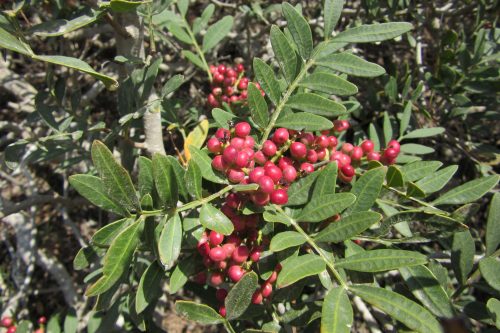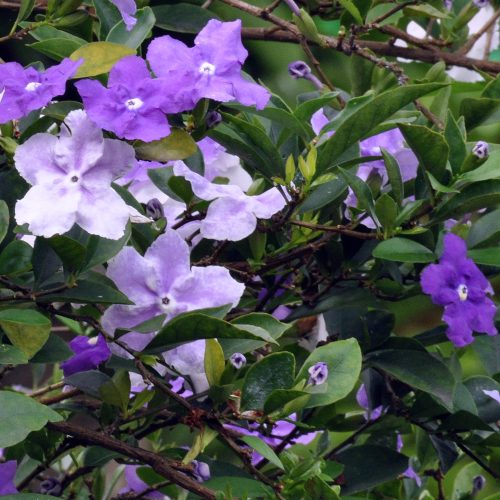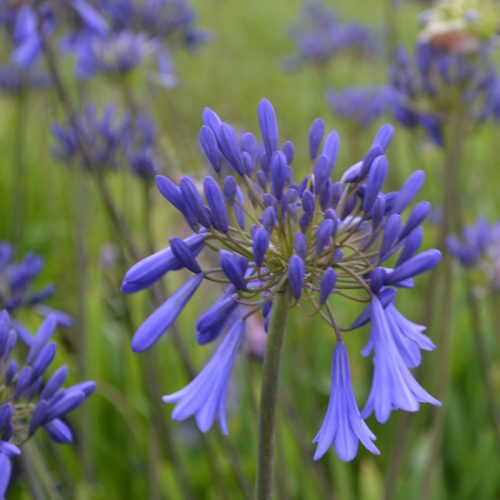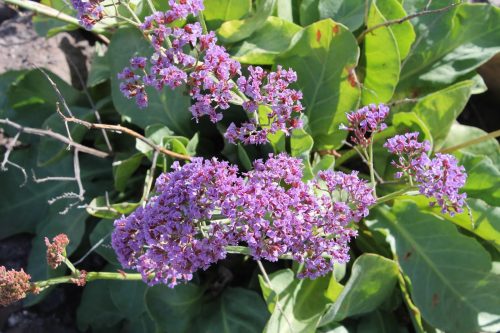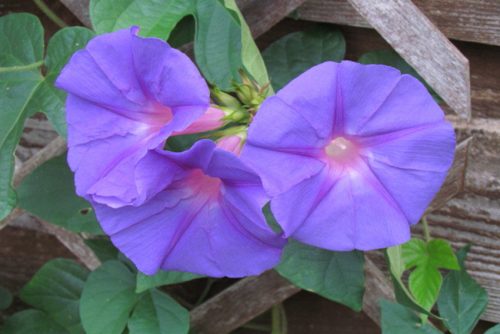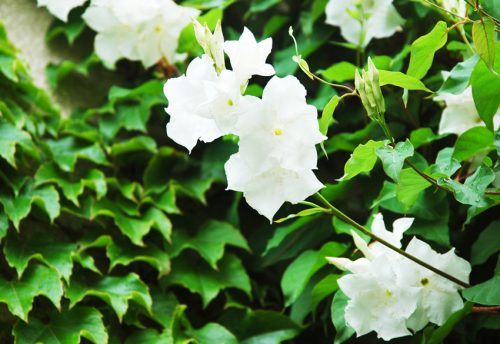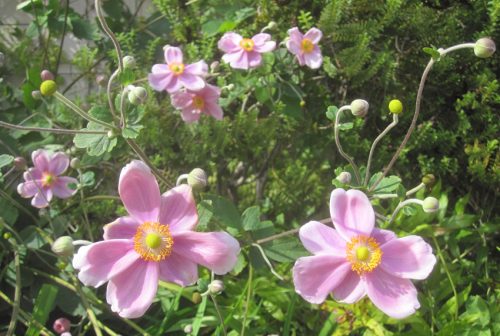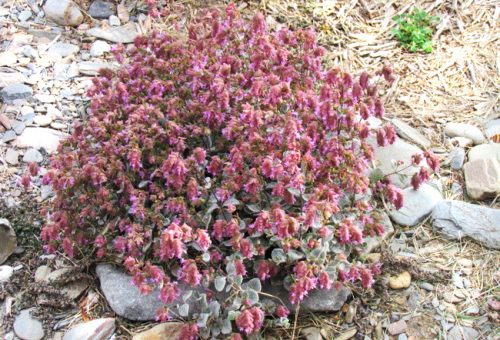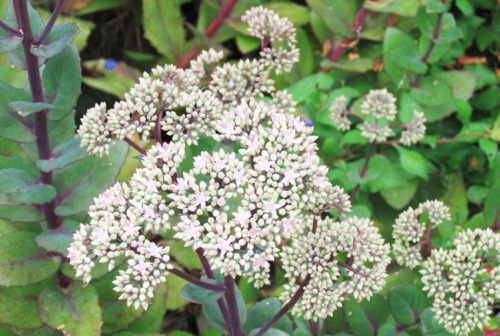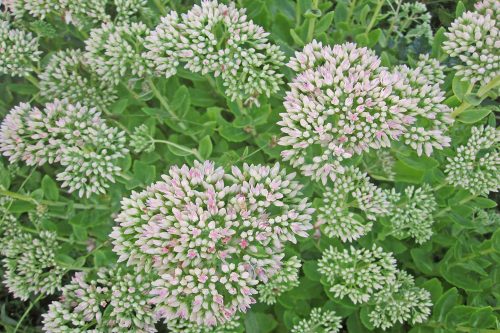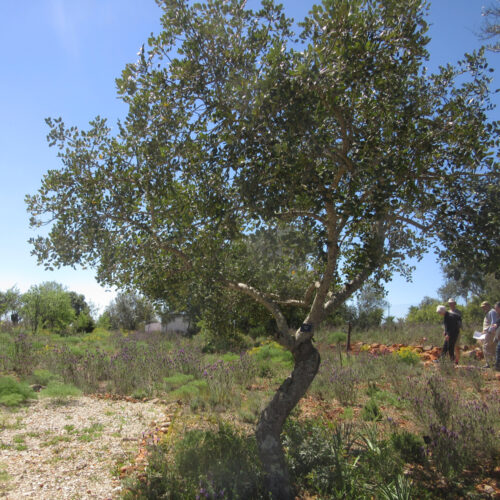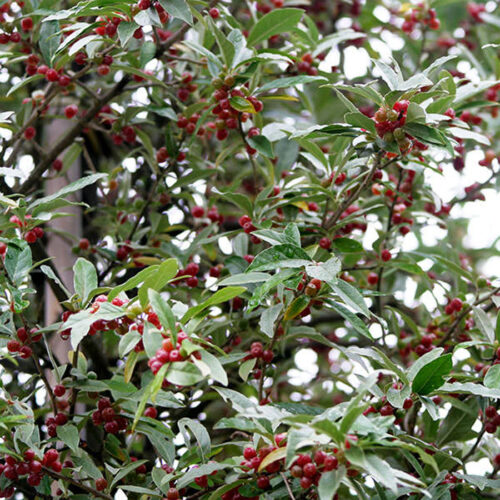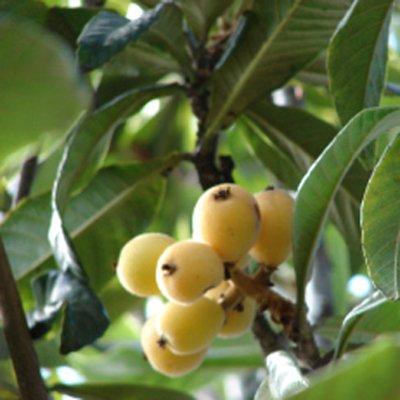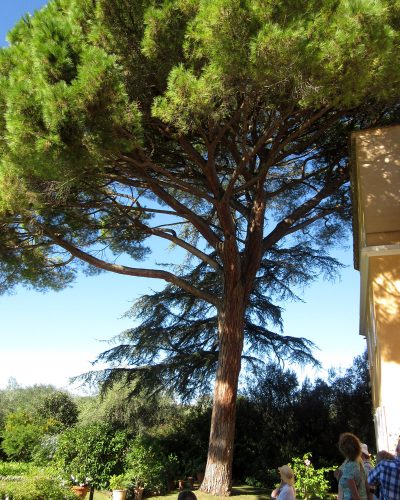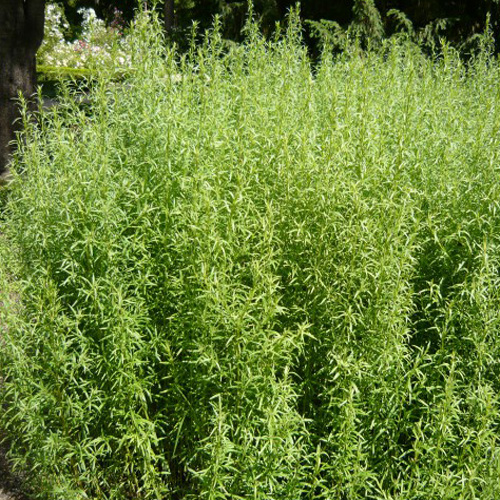Plants for under Pine Trees
Plant lists / Listes de plantes
Plants for under Pine Trees
![]()
Le Jardin Bleu
Plant lists / Listes de plantes
Le Jardin Bleu
These plants were recommended by Pierre Bianchi (MGF member, President of the Société française d’acclimatation) in a lecture, ‘The use of blue with contrasting white and yellow in a Mediterranean garden’, given to MGF and Hortus members in January 2020.
Ces plantes ont été recommandées par Pierre Bianchi (membre MGF, président de la Société française d’acclimatation) dans une conférence, ‘Le bleu et ses contrastes au jardin méditerranéen : bleu-blanc-jaune’, pour les membres de la MGF et Hortus en janvier 2020.
Sow straight into the ground in spring or summer / A semer en place au printemps ou en été
Photo: Salvia leucantha
Photo: Salvia patens
![]()
Late Summer Colour
Plant lists / Listes de plantes
Late Summer Colour
Couleur pour la fin de l’été
Photo: Campsis radicans ‘Indian Summer‘.
Photo: Caryopteris x clandonensis ‘Heavenly Blue‘.
Photo: Nerium oleander ‘Marie Gambetta‘
Photo: Aster pilosus var. pringlei ‘Monte Cassino‘.
Photo: Miscanthus sinensis ‘Zebrinus‘
Photo: Panicum virgatum ‘Heavy Metal‘.
![]()
List of comestible plants
List of Comestible Plants / Liste de plantes comestibles
(updated / mise à jour: July / juillet 2023)
A non-exhaustive list of comestible plants / Liste non exhaustive de plantes comestibles
Here you’ll find a list of plants with low water requirements, which is far from exhaustive and may be added to in the future. We should point out that the concept of ‘drought’ is fairly subjective and depends on the specific conditions in your garden (wind, type and depth of soil, exposure). On the other hand, no plant in the world can do without water, and there’s no denying that if you want good fruit, you need a minimum amount of water between flower formation and fruiting. Chantal has observed this in her garden in Montpellier, with Feijoa sellowiana: in a dry summer, you need to water them every 15 days or so if you want to have beautiful fruit in the autumn. You’ll understand that this is all a matter of personal experience and judgement.
Vous trouverez ici une liste de végétaux peu exigeant en eau qui est loin d’être exhaustive et pourra être complétée dans le futur. Nous tenons à préciser que le concept de « sécheresse » est assez subjectif et qu’il dépend des conditions spécifiques de votre jardin (vent, nature et profondeur du sol, exposition). D’autre part, Aucune plante au monde ne peut se passer d’eau, et on ne peut nier que, si on veut obtenir une bonne fructification, il faudra un minimum d’eau entre la formation des fleurs et la fructification. Chantal l’a constaté dans son jardin montpelliérain, à propos des Feijoa sellowiana : en cas d’été sec, il faut les arroser tous les 15 jours environ si on veux avoir de beaux fruits à l’automne. » Vous comprendrez que tout cela est une question d’appréciation et d’expérience personnelle.
Origin/Origine: Greece, Asia minor / Grèce, Asie mineure
Hardiness/Rusticité: -12 / -15°C
Watering/Besoin en eau: Low / Faible
Description: Height: 6m, spread: 3m. Evergreen. Young shoots are bronze coloured. Beautiful red/orange bark which peels off from the trunk. White flowers from February to April.
Description: Hauteur : 6 m, largeur : 3 m. Persistant. Les jeunes pousses prennent des teintes bronze. Remarquable écorce rouge-orangé, s’exfoliant sur le tronc. Fleur blanche de février à avril.
Cultivation: Well-drained soil, tolerates alkalinity, sun or part shade, copes with root competition on the edge of pine or oak woods.
Culture: Sol bien drainé, supporte bien le calcaire, au soleil ou à mi-ombre, supporte bien la concurrence racinaire en lisière de bois de pins ou de chênes.
Harvesting and Uses of the Fruit: The fruits are similar to those of A.unedo.
Fruit / Utilisation / Consommation / Récolte: Fruit semblable à celui de A. unedo
Origin/Origine: Hybrid. A. unedo x A. andrachne
Hardiness/Rusticité: -12 / -15°C
Watering/Besoin en eau: Low / Faible
Description: Height: 6m, spread: 3m. Red/orange bark. Leaves like A. unedo. White flowers in winter.
Description: Hauteur : 6 m, largeur : 3 m. Ecorce rouge-orangé. Feuilles de A. unedo. Floraison blanche en hiver.
Cultivation: Sun or part shade, tolerates alkaline soils.
Culture: Soleil ou mi-ombre, supporte le calcaire
Harvesting and Uses of the Fruit: The fruits are similar to those of A.unedo.
Fruit / Utilisation / Consommation / Récolte: Fruit semblable à celui de A. unedo
Origin/Origine: British Columbia, California / Colombie britannique, Californie
Hardiness/Rusticité: -12°C
Watering/Besoin en eau: Low / Faible
Description: Height: 6 to 30m. Smooth red-brown bark which flakes off in small pieces. Dark green, evergreen foliage. White flowers in spring.
Description: Hauteur : 6 à 30 m. Écorce lisse rouge-brune qui s’écaille en petits flocons. Feuillage vert sombre persistant. Floraison blanche printanière.
Cultivation: Full sun, prefers non alkaline soils.
Culture: Soleil, préfère les sols non-alcalins
Harvesting and Uses of the Fruit: Small red fruits, 1,5 cm diameter, bland to sweet taste when ripe. Use to flavour jellies.
Fruit / Utilisation / Consommation / Récolte: Petit fruit rouge, 1,5 cm de diamètre, fade à doux à maturité, consommé en gelées.
Origin/Origine: Mediterranean basin, Atlantic coast / Bassin méditerranéen, littoral atlantique
Hardiness/Rusticité: -12 / -15°C
Watering/Besoin en eau: Low / Faible
Description: Height : 5m or more. Evergreen. White flowers in October/November.
Description: Hauteur : 5 m et plus. Persistant. Floraison blanche en octobre-novembre.
Cultivation: Sun or part shade. Tolerates alkaline soils and root competition on the edge of pine or oak woods.
Culture: Soleil ou mi-ombre, supporte le calcaire, supporte bien la concurrence racinaire en lisière de bois de pins ou de chênes.
Harvesting and Uses of the Fruit: Round, red, granular fruit, 2-3 cm diameter, containing around 20 hard, dark seeds, which are attractive to birds. The fruits ripen in October to December the year after flowering. Eat raw or use to make a jelly. The Latin name, ‘unedo’ means one only needs to eat one, either because the fruit is delicious, or because the flavour is uninteresting. The skin has a slightly granular texture and the flesh is similar to a tropical fruit, with a delicate flavour which may be appreciated by people with sensitive taste buds. The fruit has a 20% sugar content and can be used to make nourishing jams and jellies. When fully ripe, the fruit falls from the tree, and it is therefore advisable to surround it with grass in order to cushion the fruit’s fall.
Fruit / Utilisation / Consommation / Récolte: Fruit rouge et arrondi, granuleux (2-3 cm diamètre), contenant une vingtaine de graines dures et foncées, attractifs pour les oiseaux, d’octobre à décembre (mûrissant un an après floraison). Bons crus ou cuits en gelée. Doux mais insipide. Le nom latin «unedo» signifie «je mange une (seule)». Un rapport dit que le fruit est tellement délicieux qu’une personne a seulement besoin d’en manger un. Il possède une peau légèrement granuleuse, mais le fruit lui-même a la texture d’un fruit tropical luxuriant et possède une agréable saveur délicate. Pour les personnes ayant des papilles sensibles, c’est un fruit qui peut être apprécié. Le fruit contient environ 20% de sucres et peut être utilisé pour faire de délicieuses et nourrissantes confitures et conserves. Il est mûr en novembre/décembre et est d’environ 15 mm de diamètre. Lorsqu’il sera pleinement mûr, il tombe de l’arbre et il est donc conseillé de cultiver la plante dans l’herbe afin d’amortir la chute du fruit.
Origin/Origine: California / Californie
Hardiness/Rusticité: -5°C
Watering/Besoin en eau: Water only in its first year / Arrosage seulement la première année
Description: Height : from 1 to over 6m. White flowers at the end of winter. Dark reddish-brown bark.
Description: Hauteur : de 1 à plus de 6 m. Floraison blanche en fin d’hiver. Ecorce brun-rougeâtre foncé.
Cultivation: Full sun. Sandy, silt, clay or acid soil.
Culture: Soleil, sol sableux, limon, argile et acide.
Harvesting and Uses of the Fruit: Light red, round or egg-shaped fruit, 12-15 mm wide, covered with hard, sticky hair and containing a thick pulp.
Fruit / Utilisation / Consommation / Récolte: drupe ronde ou en forme d’œuf de 12 à 15 mm de large, rouge clair, pulpe épaisse recouverte d’un poil dur et collant.
Origin/Origine: South America / Amérique du sud
Hardiness/Rusticité: -12 / -9°C
Watering/Besoin en eau: Low / Faible
Description: Height 5m, spread 4m. The foliage is grey/green to blue/green. Flowers varying from yellow to red appear in summer on older plants.
Description: Hauteur 5 m, largeur 4 m. Feuillage de couleur vert-gris à vert-bleuté. Floraison estivale sur des plantes âgées variant du jaune au rouge.
Cultivation: Requires a lot of sun and prefers a lightly acidic soil. Easy to grow in a pot, needs little maintenance.
Culture: Exige beaucoup de soleil. Préfère un sol à tendance acide. Culture en pot possible, facile, peu d’entretien.
Harvesting and Uses of the Fruit: Fleshy, ovoid, red-orange fruits, 3cm long and slightly pointed at the end. The pulp, fibrous but juicy, tastes similar to a pineapple, mirabelle plum or mango. The fruits are quite rich in vitamin C and are used locally for making delicious jellies, liqueurs (palm wine) or to flavour punches. The ovoid or triangular seeds are 1.5 to 2.5 cm long and have a daimeter of 1 to 1.4 cm. Each bunch of fruit can weigh more than 30 kilos. Each fruit contains a seed with a very hard shell, like a tiny coconut, on which are the 3 pores characteristic of the coconut fruit.
Fruit / Utilisation / Consommation / Récolte: Fruits charnus, de forme ovoïde, de couleur rouge-orangé, longs de 3 cm et légèrement pointus à leur extrémité. La pulpe, fibreuse mais juteuse, recèle une saveur plus ou moins proche de celle de l’ananas, de la mirabelle ou de la mangue. Ces fruits sont assez riches en vitamine C et entrent localement dans la confection de délicieuses gelées, de liqueurs (Vin de palme) ou à aromatiser les punch. Les graines ovoïdes ou triangulaires varient de 1,5 à 2,5 cm de long sur 1 à 1,4 cm de diamètre. Les “régimes” de fruits peuvent peser plus de 30 kilos. Chaque fruit contient une graine à coque très dure, sorte de minuscule noix de coco, sur laquelle on distingue 3 pores caractéristique des fruits des cocotiers.
Origin/Origine: Mediterranean basin / Bassin méditerranéen
Hardiness/Rusticité: -7 / -1°C
Watering/Besoin en eau: Very low / Très faible
Description: Height: < 2m. Simply shaped, alternate leaves. Solitary white flowers from April to September. Not prickly.
Description: Hauteur : < 2m. Feuilles alternes de forme simple entière. Fleurs solitaires de couleur blanche. Fleurit d’avril à septembre. Non épineux
Cultivation: Plant in sun or half shade, any soil.
Culture: Exposition : soleil ou mi-ombre, sol basique
Harvesting and Uses of the Fruit: The flower buds and young fruits can be eaten in brine or vinegar. They are rich in vitamin A and mineral salts.
Fruit / Utilisation / Consommation / Récolte: Boutons floraux et fruits jeunes comestibles en saumure ou au vinaigre. Médicinale : Vitamine A et sels minéraux.
Origin/Origine: Mediterranean basin / Bassin méditerranéen
Hardiness/Rusticité: -9 / -6°C
Watering/Besoin en eau: Very low / Très faible
Description: Height and spread: 0.5 to 1.5m. Magnificent white flowers with purple stamens from June to September. ‘Inermis’ is a non-thorny variety.
Description: Hauteur et largeur : 0,5 à 1m50, magnifiques fleurs blanches à étamines violettes de juin à septembre. Variété sans épines ‘Inermis’
Cultivation: Plant in full sun, on top of a small wall. Tolerates alkaline soils.
Culture: Soleil. La plante doit être plantée en haut d’un muret, supporte bien le calcaire.
Harvesting and Uses of the Fruit: The flower buds and young fruits can be eaten in brine or vinegar. They are rich in vitamin A and mineral salts.
Fruit / Utilisation / Consommation / Récolte: Boutons et fruits jeunes comestibles en saumure ou au vinaigre. Médicinale.
Origin/Origine: South Africa / Afrique du sud
Hardiness/Rusticité: -3 / -1°C
Watering/Besoin en eau: Water for the first 2 or 3 years / Arroser les 2 ou 3 premières années
Description: Height 3m, spread 3.5m. A thorny evergreen shrub with white scented flowers (jasmine perfume) from May to September.
Description: Hauteur 3 m, largeur 3,5 m. Arbuste épineux persistant. Fleurs blanches parfumées (jasmin) de mai à septembre.
Cultivation: Sun or half shade. All soil types. Suitable for planting in pots.
Culture: Soleil ou mi-ombre.Tous sols, possibilité en bac.
Harvesting and Uses of the Fruit: The fruit is fleshy, smooth, oval to oblong, 4 to 6cm long and 2 to 4cm wide. It’s colour turns to magenta when it is ripe and ready for eating. Juicy, with a mild, sweet flavour the fruits are rich in vitamin C and contain around fifteen small, flat, brown seeds that are toxic if ingested. Good for making into jellies.
Fruit / Utilisation / Consommation / Récolte: Fruit charnu, lisse, ovale à oblong, long de 4 à 6cm et large de 2 à 4cm. Mûrs et comestibles lorsqu’ils prennent une couleur rouge magenta. A la fois juteux, sucrés, riches en vitamine C et de saveur douce, ils contiennent une quinzaine de petites graines brunes et plates, toxiques par ingestion. On confectionne avec ces jolies ‘prunes’ une délicieuse gelée.
Origin/Origine: South Africa / Afrique du sud
Hardiness/Rusticité: -6 / -3°C
Watering/Besoin en eau: No watering needed / Sans arrosage
Description: Height: 20 – 40cm. A creeping plant considered invasive in the wild. Dark red, yellow, pink, purple and violet flowers from May to October.
Description: Hauteur : 20 à 40 cm. Plante rampante considérée comme invasive en milieu naturel. Fleurs de couleur rouge foncé, jaune, rose, pourpre et violet de mai à octobre. .
Cultivation: Full sun in poor,dry, well-drained soils.
Culture: Plein soleil, sol drainé, pauvre et sec
Harvesting and Uses of the Fruit: In the shape of a fig, the very fleshy fruits are edible and are popular in jam, due to their slightly acidic taste.
Fruit / Utilisation / Consommation / Récolte: En forme de figue, ses fruits très charnus sont comestibles et sont très appréciés en confiture, de par leur goût légèrement acidulé.
Origin/Origine: Mediterranean basin / Bassin méditerranéen
Hardiness/Rusticité: -15 / -12°C
Watering/Besoin en eau: Water in its first year / Arroser la première année
Description: Height: 20 – 30m. In a deep,acidic and well-drained soil, the tree will be very long-lived. Pale yellow flower in June-July.
Description: Hauteur: 20 à 30 m. Dans un sol acide, profond et bien drainé, il sera d’une très grande longévité. Fleur jaune pâle en juin-juillet.
Cultivation: Sun or shade. Acid soil.
Culture: Soleil ou ombre, sol acide
Harvesting and Uses of the Fruit: The well-known edible chestnuts can be used in patisserie and for a variety of dishes. Harvest time is September – October.
Fruit / Utilisation / Consommation / Récolte: les fameux marrons comestibles en confitures, patisseries et cuisine. Récolte de septembre à octobre.
Origin/Origine: Asia minor / Asie Mineure
Hardiness/Rusticité: -5°C
Watering/Besoin en eau: Low / Faible
Description: Height 8 -12m. Slow grwing. Greenish flowers.
Description: Hauteur 8 à 12 m. Croissance lente. Floraison verdâtre.
Cultivation: Sun or part shade, shelter from cold winds. Any soil, including poor and stony, but must be well-drained.
Culture: Soleil ou mi-ombre abrité des vents froids. Sol indifférent, même pauvre, caillouteux surtout bien drainé.
Harvesting and Uses of the Fruit: One year after flowering, long fragrant, pendulous purplish-brown pods appear, containing about fifteen edible, brown, flat seeds of the same weight.They are coated in a sweet fleshy pulp, edible when ripe. Each seed having a constant weight of 200mg, is how the carat was born, used as a unit of measurement for precious stones. Low sugar carobs are rich in starch, proteins, tannins and mineral salts. The pods After drying and roasting the pods are used as a cocoa substitute. Medicinal.
Fruit / Utilisation / Consommation / Récolte: Caroube. Une année après la floraison longues gousses parfumées, arquées, pendantes d’un brun violacé contenant une quinzaine de graines comestibles, brunes, plates au poids constant. Elles sont enrobées dans une pulpe charnue grasse et sucrée, comestible à maturité. Chaque graine ayant un poids constant de 200mg, c’est ainsi que naquit le carat qui est utilisé comme unité de mesure pour les pierres précieuses. Les caroubes faiblement sucrées, sont riches en amidon, protéines, tanins et sels minéraux. Les cosses après séchage et torréfaction sont utilisées comme substitut de cacao. Médicinal.
Origin/Origine: Europe, Asia minor, Algeria / Europe, Asie mineure, Algérie
Hardiness/Rusticité: -34 / -28°C
Watering/Besoin en eau: Medium. Drought tolerant / Moyen. Supporte la sécheresse
Photo: Corylus avellana ‘Contorta‘
Description: Height 5m. Monoecious (*1) shrub. The yellow catkins are the male flowers and the buds with red stigmas are the female ones. Fast-growing.
Description: Hauteur 5 m. Arbuste monoïque. Les chatons de couleur jaune sont les fleurs mâles et les bourgeons à stigmates rouges sont les fleurs femelles. Croissance rapide.
Cultivation: Sun, with half-shade in summer. Any soil, Prefers a cool situation.
Culture: Soleil et mi-ombre en été. Tous sols. Préfère un sol frais.
Harvesting and Uses of the Fruit: Hazelnuts are achenes ( single-seeded dry fruit). They are yellow-green, then brown when ripe. Grouped in clusters of 1 to 4, they are 2 cm in diameter. Harvest end August, early September.
Fruit / Utilisation / Consommation / Récolte: akènes qui sont nommés noisettes. Ils sont jaune-vert puis brun à maturité. Groupés par 1 à 4, ils mesurent 2 cm de diamètre. La récolte se fait à la fin août, début septembre.
Origin/Origine: Mediterranean basin / Bassin méditerranéen
Hardiness/Rusticité: -15 / -12°C
Watering/Besoin en eau: Very low / Très faible
Description: Height 10m, spread 5m. A small, slow-growing and undemanding tree, unfairly neglected by gardeners but rewarding to grow in the Mediterranean region. Deciduous. Flowers in April.
Description: Hauteur 10 m, largeur 5 m. Petit arbre de croissance lente, sans exigence, injustement délaissé, très gratifiant dans la région méditerranéenne. . Le feuillage est caduc. La floraison a lieu en avril.
Cultivation: Adapts to any type of soil, including alkaline and summer dry.
Culture: Il s’adapte à toute terre de jardin, même calcaire et sèche en été.
Harvesting and Uses of the Fruit: The tree only fruits in Mediterranean-climate regions. Fruits are globular, 2 – 4cm in diameter and ripen in September. Eat raw or made into compotes or jelly.
Fruit / Utilisation / Consommation / Récolte: La fructification n’est possible que sous un climat méditerranéen. Les fruits globuleux de 2 à 4cm de diamètre sont mûrs en septembre, consommés crus ou cuits en compotes ou gelées.
Origin/Origine: Caucasia, Iran / Caucase, Iran
Hardiness/Rusticité: -25°C
Watering/Besoin en eau: Low / Faible
Description: Height 4m, spread 2m. Ornemental. Soft pink flowers in April-May.
Description: Hauteur 4 m, largeur 2 m. Ornemental. Fleur rose tendre en avril-mai.
Cultivation: Full sun. Any non-compacted soil.
Culture: Soleil. Terre ordinaire bien ameublie
Harvesting and Uses of the Fruit:
Fruit / Utilisation / Consommation / Récolte: Coings
Origin/Origine: China / Chine
Hardiness/Rusticité: -15 / -12°C
Watering/Besoin en eau: Medium. Drought tolerant / Moyen. Supporte la sécheresse
Photo: Diospyros kaki ‘Fuyu‘
Description: Height 6m. Deciduous shrub. Yellow-green flowers in June.
Description: Hauteur 6m. Arbuste caduc. Fleur jaune-verdâtre en juin.
Cultivation: Sun, but prefers cool ground.
Culture: Soleil. Préfère un sol frais.
Harvesting and Uses of the Fruit: The fruit mature from October to November, taking on a bright orange colour. They remain hard until after leaf fall. The flavour is a little tart due to the presence of tannins but they are rich in sugar, Vitamin C , beta-carotene, potassium, calcium, magnesium and various trace elements. Do not harvest them until after a light frost, the fruit becoming edible only when slightly over-ripe. The cultivar ‘Fuyu’ produces fruit which can be consumed quite early in the season because its firm orange flesh is sweet and not too astringent.
Fruit / Utilisation / Consommation / Récolte: Les fruits murissent d’octobre à novembre en prenant une teinte orange vif. Ils restent très tard après la chute des feuilles. Leur saveur est un peu âcre en raison de la présence de tannins mais ils sont riches en sucres, vitamine C, provitamine A, Potassium, Calcium, Magnésium et divers oligoéléments. Ils ne se récoltent pas avant la mi-novembre. Les fruits ne sont consommables que presque blets, après le passage d’une petite gelée. Le cultivar ‘Fuyu’ produit des fruits qui peuvent être consommés assez tôt en saison, car leur chair orangée est ferme, sucrée et peu astringente.
Origin/Origine: South Africa / Afrique du sud
Hardiness/Rusticité: -6°C (for short periods / sur de courtes périodes)
Watering/Besoin en eau: Low / Faible
Description: Height 3 – 6m. Dioecious (*2) thorny shrub. Discreet yellow flowers. There are examples of this shrub in the botanical garden of Montpellier.
Description: Hauteur 3 à 6m. Arbuste épineux dioïque. Floraison discrète jaune. On peut en voir au jardin des plantes de Montpellier.
Cultivation: Sunny position in well-drained, rich and fertile soil.
Culture: Soleil. Sol fertile, humifère et surtout bien drainé.
Harvesting and Uses of the Fruit: Globular fruit in August-September (3 cm diameter)with a velvety but bitter orange skin, which turns brownish-purple when ripe. The purple-red pulp is tangy and juicy.
Fruit / Utilisation / Consommation / Récolte: Fruits en août-septembre, globuleux (3 cm de diamètre) à la peau orange fine et veloutée mais amère, virant au pourpre marron à maturité contenant une pulpe d’un rouge pourpré acidulée et juteuse.
Origin/Origine: Eastern Asia / Asie orientale
Hardiness/Rusticité: -28 / -23°C
Watering/Besoin en eau: Needs no watering once established / Une fois bien établi, se passe totalement d’arrosage
Description: Height up to 4m, spread 3m. Grows rapidly, more or less deciduous, with a flared shape and soft, bushy habit. It is noticeable from afar, due to the clarity and silvery sheen of its ever-moving foliage.Pale yellow flowers in May-June. Attractive to bees.
Description: Hauteur jusqu’à 4 m, largeur 3 m. Croissance rapide, plus ou moins caduc, port large, touffu mais souple et évasé . Il se remarque de loin, en raison de la clarté et de l’éclat argenté de son feuillage toujours en mouvement. Floraison jaune pâle en mai-juin. Plante mellifère.
Cultivation: Sun or half shade. Any ordinary alkaline soil with a coarse and airy texture.
Culture: Soleil ou mi-ombre. Sol calcaire ordinaire, de texture plutôt grossière et aérée.
Harvesting and Uses of the Fruit: Small rounded, fleshy fruits, of a beautiful red punctuated with silver when ripe. They are sweet and tangy and can be eaten eaten raw, in compotes or jams. There are several cultivars.
Fruit / Utilisation / Consommation / Récolte: Petits fruits arrondis, charnus, d’un beau rouge ponctué d’argent à maturité. Ils sont sucrés et acidulés, se dégustent crus, en compotes ou en confitures. Il existe plusieurs cultivars.
Origin/Origine: China / Chine
Hardiness/Rusticité: -9 / -6°C
Watering/Besoin en eau: Needs no watering once established / Une fois bien établi, se passe totalement d’arrosage
Description: Height 6m. Beautifol form and foliage. Creamy white, almond scented flowers in autumn.
Description: Hauteur 6 m. Arbuste ornemental par la beauté de son port et de son feuillage. Floraison d’automne blanc-crème au parfum d’amande.
Cultivation: Sun or half shade. Deep alkaline clay soil.
Culture: Soleil ou mi-ombre. Sol ordinaire mais profond, argilo-calcaire.
Harvesting and Uses of the Fruit: The loquat fruit is ovoid in shape and yellow-orange when ripe (in May-June depending on the region). It is 3 cm in diameter and has a juicy and slightly acidic flesh, very refreshing. It can be eaten raw or cooked in a compote.
Fruit / Utilisation / Consommation / Récolte: Le fruit appelé bibasse ou nèfle, de forme ovoïde, est de couleur jaune-orangé à maturité (en mai-juin selon les régions). Il mesure 3 cm de diamètre et possède une chair juteuse et légèrement acidulée, très rafraîchissante. Il est consommé frais, cru ou cuisiné en compote.
Origin/Origine: South America / Amérique du sud
Hardiness/Rusticité: -12 / -9°C
Watering/Besoin en eau: Medium / Moyen
Description: Height 4m. A bushy shrub, both fruit-bearing and ornamental. Beautiful white flowers in May-June.
Description: Hauteur 4 m. Arbuste au port buissonant, non seulement fruitier mais ornemental. Belle floraison blanche en mai-juin.
Cultivation: Plant in a sunny spot in silty clay soil. Cut back slightly in spring because fruiting takes place on the current year’s growth.
Culture: Soleil. Sol argilo-limoneux. Rabattre légèrement au printemps car la fructification a lieu sur les rameaux de l’année.
Harvesting and Uses of the Fruit: Small, elongated, green, fleshy fruit with a rough skin and white flesh. Rich in vitamin C, its taste is reminiscent of pineapple, guava and strawberry. Harvest in October and November. Feijoa can be eaten raw, cut in half and eaten with a spoon or made into jams and compotes. It is a fruit that does not keep well.
Fruit / Utilisation / Consommation / Récolte: Fruit petit, allongé, vert et charnu, à la peau rugueuse et à la chair blanche. Riche en vitamine C, son goût rappelle l’ananas, la goyave et la fraise. La récolte s’effectue en octobre et novembre. Le feijoa se consomme nature, coupé en deux et dégusté à la cuillère ou se transforme en confitures et compotes. C’est un fruit se conservant peu.
Origin/Origine: Afghanistan, Syria / Afghanistan, Syrie
Hardiness/Rusticité: -10°C
Watering/Besoin en eau: Water in the first 2 or 3 years / Arroser les 2 ou 3 premières années
Photo: Ficus carica ‘Ronde de Bordeaux‘
Description: Height: 3 – 10m according to the variety.
Description: Hauteur : 3 à 10 m selon variétés. Ornemental.
Cultivation: All soils. Plant in a sunny spot sheltered from cold winds. Pruning is essential to promote creation of a good shape.
Culture: Tous sols, exposition ensoleillée à l’abri des vents froids ; Taille indispensable pour favoriser la ramification
Harvesting and Uses of the Fruit: Figs can be purple, green or white. Most figs fruit twice each year, in July then again in September. Figs do not ripen further once picked. Harvest when ripe (good colour, soft. easy to detach from the tree) and eat quickly because figs do not keep for more than two days in the fridge.
Fruit / Utilisation / Consommation / Récolte: Les figues peuvent être violettes, vertes ou blanches. La plupart des figuiers sont bifères, c’est à dire qu’ils donnent des fruits en juillet puis en septembre. La figue ne mûrit plus une fois qu’elle est cueillie. Elle se récolte à maturité (colorée, souple, se détachant bien) et se consomme rapidement car elle ne se conserve guère plus de deux jours au réfrigérateur.
Origin/Origine: Northern Europe / Europe du nord
Hardiness/Rusticité: -34 / -28°C
Watering/Besoin en eau: Low / Faible
Description: Height and spread 3 – 5m, a thorny dioecious shrub which is very resistant to cold and sea spray. Its orange berries are very decorative.
Description: Hauteur et largeur 3 à 5 m, arbuste dioïque épineux, très résistant au froid et aux embruns. Ses baies de couleur orangé sont très décoratives.
Cultivation: Plant in a sunny spot in ordinary or poor soil to create a protective hedge.
Culture: Soleil. Se plait en sol ordinaire ou pauvre pour former des haies défensives.
Harvesting and Uses of the Fruit: Both male and female plants are necessary for fruiting to take place. The bright orange berries are round to oval and stay on the shrub all winter. Rich in vitamin C and antioxidants, sea buckthorn can be eaten in the form of jams, syrups or jellies.
Fruit / Utilisation / Consommation / Récolte: Pieds mâle et femelle nécessaires pour la fructification. Baies rondes à ovales, d’un orange bien vif qui persistent sur l’arbuste tout l’hiver. Riches en vitamine C et en anti-oxydants, les argouses se consomment sous forme de confitures, sirops ou gelées.
Origin/Origine: Mexico / Mexique
Hardiness/Rusticité: 0°C
Watering/Besoin en eau: Low. In a pot, once every 10 days in the growing season, once a month in winter / Faible. En pot: 1 fois chaque 10 jours en période de croissance; 1 fois par mois en hiver
Description: This climbing cactus epyphyte can reach 3m in height in a greenhouse.Large perfumed white nocturnal flowers.
Description: Cactus épiphyte grimpant de 3 m de haut en serre. Grosses fleurs blanches nocturnes et parfumées.
Cultivation: Rich soil and bright sunshine. Ideal temperature between 15 and 25°C.
Culture: Sol humifère, exposition ensoleillée très lumineuse. Température idéale entre 15 et 25°C.
Harvesting and Uses of the Fruit: Self-sterile: you need 2 plants to get the decorative fruit, which have a pink skin and flesh. Rich in vitamin C and mineral salts, they can be eaten raw, as juice, in sorbet or in fruit salads.
Fruit / Utilisation / Consommation / Récolte: Autostérile : nécessité d’avoir 2 pieds pour obtenir des fruits. Fruits à peau et chair rose, originaux et décoratifs, riches en vitamine C et sels minéraux. Ils se consomment crus, en jus, en sorbet ou en salades de fruits.
Origin/Origine: China / Chine
Hardiness/Rusticité: -28°C
Watering/Besoin en eau: Low / Faible
Description: Height and spread 10m. A fast-growing deciduous tree, excellent as a shade provider. Its leaves have been used to feed silk worms from time immemorial.
Description: Hauteur et largeur 10 m. Arbre caduc, croissance rapide, excellent arbre d’ombrage. Ses feuilles servent de nourriture aux vers à soie depuis des temps immémoriaux.
Cultivation: Needs a hot, sunny spot with fertile soil. Tolerates pollution but dislikes the seaside and sea spray. Can be hard-pruned.
Culture: Sol fertile en situation chaude et ensoleillée. Supporte bien la pollution mais redoute le bord de mer et les embruns. Supporte bien la taille.
Harvesting and Uses of the Fruit: The fruit varies from pinky white to shades of red and dark purple and is picked at the end of spring. The flavour is a little bland, but juicy and sweet. The fallen fruit do not stain the ground.
Fruit / Utilisation / Consommation / Récolte: Fruit blanc rosé à rouge violacé, voire noirâtre, récolté en fin de printemps. Saveur un peu fade, juteuse et sucrée. Ne tache pas le sol en tombant.
Origin/Origine: Western Asia / Asie occidentale
Hardiness/Rusticité: -20 / -17°C
Watering/Besoin en eau: Low / Faible
Description: Excellent deciduous shade tree, to 12m high. It has a short, thick trunk which, with age, takes on a gnarled and twisted appearance. Its leaves turn golden yellow in autumn.
Description: Excellent arbre d’ombrage caduc de 12 m de haut. Tronc court et épais qui prend, avec l’âge un aspect noueux et tourmenté. Son feuillage vire au jaune d’or à l’automne.
Cultivation: Prefers a rich, fertile soil and full sun. Tolerates alkaline soils. Take care not to over-prune.
Culture: Sol plutôt fertile et profond, en plein soleil. Supporte très bien le calcaire. Les tailles sévères sont à éviter.
Harvesting and Uses of the Fruit: Violet-red fruit, almost black when mature, have a tangy, fragrant flavour, but stain the ground. They can be eaten fresh, in jellies, jams or syrups.
Fruit / Utilisation / Consommation / Récolte: Fruits rouge violacé, presque noirs à maturité, recèlent une saveur acidulée et parfumée, mais ils tâchent le sol. Ils se consomment frais, en gelées, confitures ou sirops.
Origin/Origine: Mediterranean basin / Bassin méditerranéen
Hardiness/Rusticité: -12 / -9°C
Watering/Besoin en eau: Low. Water the first two summers / Faible. Arroser les 2 premiers étés
Description: A small tree, inseparable from the Mediterranean landscape. Grows slowly.
Description: Petit arbre indissociable du paysage méditerranéen, croissance lente.
Cultivation: Prune once per year in March, April or May. Prefers a dry, alkaline, clay loam soil.
Culture: Tailler au moins 1 fois par an en mars, avril ou mai, sol argilo-limoneux, calcaire et sec
Harvesting and Uses of the Fruit: Olives are fleshy green drupes with a hard stone, turning black when ripe.
Fruit / Utilisation / Consommation / Récolte: Les olives sont des drupes charnues à noyau dur, vertes puis noires à maturité.
Origin/Origine: Mexico / Mexique
Hardiness/Rusticité: -5°C
Watering/Besoin en eau: Low. Never water between September and April / Faible. Ne jamais arroser de septembre à avril
Description: Can grow to 5m in height. Distinguished by its broad,spatulate greyish-green stems with a few thorns (some varieties are thornless). Bright yellow flowers in June.
Description: Il peut atteindre 5 m de haut. Remarquable par ses larges segments aplatis vert-grisâtre avec un ou deux aiguillons (certaines variétés sont inermes). Floraison jaune brillant en juin.
Cultivation: Plant in a sunny sie with extremely well-drained soil.
Culture: Soleil. Sol extrêmement drainé.
Harvesting and Uses of the Fruit: Ovoid fruit with a sweet flesh which can be eaten raw. In Mexico the ‘raquettes’ are cooked on the barbecue.
Fruit / Utilisation / Consommation / Récolte: Fruits ovoïdes à chair douce, consommés frais et les « raquettes » cuites au barbecue (Mexique).
Origin/Origine: South America / Amérique du sud
Hardiness/Rusticité: -2°C
Watering/Besoin en eau: Medium / Moyen
Description: Height 1m. This lant is sensitive to cold so grow as an annual in France. Grows quickly and has kellow flowers in May.
Description: Hauteur 1 m. Plante vivace frileuse cultivée comme annuelle chez nous. Croissance rapide. Floraison jaune en mai.
Cultivation: Sow seeds between May and July in a sunny site with silty clay soil.
Culture: Les semis s’effectuent de mai à juillet. Sol argilo-limoneux au soleil.
Harvesting and Uses of the Fruit: Small yellow to bright orange fruit encased in a calyx in the shape of a Chinese lantern. Harvest from August to October. The tangy flavour is reminiscent of a tangerine. They are used to decorate pastries or in compote, jams, and clafoutis, or can be an ingredient in the Mexican sauce, salsa verde.
Fruit / Utilisation / Consommation / Récolte: Petits fruits jaunes à orange vif enchâssés dans un calice en forme de lampion chinois à récolter d’août à octobre. Saveur quelque peu acidulée rappelant celle de la mandarine. Ils sont utilisés en décoration sur les pâtisseries mais aussi en compote, confitures, en clafoutis, mais aussi dans la sauce mexicaine Salsa verde.
Origin/Origine: Mediterranean basin / Bassin méditerranéen
Hardiness/Rusticité: -12 / -9°C
Watering/Besoin en eau: Low / Faible
Description: Conifer, to 20m high. Grows quickly, resists sea spray and drought.
Description: Conifère de 20 m de haut, croissance rapide, parfaitement résistant aux embruns et à la sécheresse.
Cultivation: A sunny position in silty clay soil, sandy or alkaline.
Culture: Soleil, sol argilo-limoneux, sablonneux et calcaire.
Harvesting and Uses of the Fruit: It takes three years for the ripe pine cone to peel off its large brown scales to release the pine nuts, which are covered in black dust. The very hard, light brown shell protects the edible and very aromatic kernel.
Fruit / Utilisation / Consommation / Récolte: Il faut attendre 3 ans pour que la pomme de pin, mûre, écarte ses grosses écailles brunes pour libérer les pignons couverts d’une poussière noire. L’enveloppe très dure, brun clair, protège l’amande comestible et très aromatique.
Origin/Origine: Middle East, Central Asia / Moyen-Orient, Asie centrale
Hardiness/Rusticité: -15 à -20°C (according to the variety / selon les variétés)
Watering/Besoin en eau: Low / Faible
Description: Height 6 – 10m. Deciduous, very hardy, slow-growing.
Description: Hauteur 6 à 10 m. Caduc très rustique, croissance lente.
Cultivation: Tolerates most soils provided they are well drained. It also tolerates a little alkalinity. Sunny exposure. To bear fruit, it needs to be cross-pollinated, so plant one male and one female plant.
Culture: Tolère la plupart des sols à condition qu’ils soient bien drainés. Il supporte également un peu de calcaire. Exposition ensoleillée. Pour fructifier, il lui faut une pollinisation croisée, donc il faut planter un pied mâle et un pied femelle.
Harvesting and Uses of the Fruit: Pistachios are very rich in copper, magnesium and potassium and contain many proteins. Harvest from August to September.
Fruit / Utilisation / Consommation / Récolte: Les pistaches sont très riches en cuivre, magnésium et potassium et renferme de nombreuses protéines. Récolte du mois d’août au mois de septembre.
Origin/Origine: Western Europe / Europe de l’Ouest
Hardiness/Rusticité: -15 / -12°C
Watering/Besoin en eau: Medium / Moyen
Description: Height 5 – 6m
Description: Hauteur 5 à 6 m
Cultivation:
Culture:
Harvesting and Uses of the Fruit: Apricot
Fruit / Utilisation / Consommation / Récolte: Abricot
Origin/Origine: Horticultural / horticole
Hardiness/Rusticité: -15 / -12°C
Watering/Besoin en eau: Medium / Moyen
Description: Height 5 – 7m
Description: Hauteur 5 à 7 m
Cultivation:
Culture:
Harvesting and Uses of the Fruit: Plum, Greengage, Damson, Mirabelle
Fruit / Utilisation / Consommation / Récolte: Prune, Reine-Claude, quetsche, mirabelle
Origin/Origine: Mediterranean basin / Bassin méditerranéen
Hardiness/Rusticité: -9 / -6°C
Watering/Besoin en eau: Low / Faible
Description: Height 8m
Description: Hauteur 8 m
Cultivation:
Culture:
Harvesting and Uses of the Fruit: Almond
Fruit / Utilisation / Consommation / Récolte: Amande
Origin/Origine: Horticultural / horticole
Hardiness/Rusticité: -15 / – 12°C
Watering/Besoin en eau: Medium / Moyen
Description: Height 4 – 5m
Description: Hauteur 4 à 5 m
Cultivation:
Culture:
Harvesting and Uses of the Fruit: Peach
Fruit / Utilisation / Consommation / Récolte: Pêche
Origin/Origine: China / Chine
Hardiness/Rusticité: -20 / -17°C
Watering/Besoin en eau: Low. Water in the first 2 or 3 years / Faible. Arroser les 2 ou 3 premières années
Description: Height 5m. all year round interest thanks to its beautiful bark, and pink spring flowers followed by large, fragrant, edible quinces. Rather slow growing, evergreen in mild climates. It differs from the common quince due to its shiny, finely serrated foliage, the absence of thorns, and its solitary pink flowers.
Description: Hauteur 5 m. Offre un intérêt permanent grâce à sa très belle écorce, sa floraison printanière rose suivie de gros coings comestibles et odorants. Croissance plutôt lente, feuillage persistant en climat doux. Il se distingue du cognassier commun par son feuillage luisant finement denté en bordure, l’absence d’épines, et ses fleurs roses solitaires.
Cultivation: Requires long, hot summers. Suitable for any free draining soil.
Culture: Exige de longs étés chauds. Il s’adapte à tous les sols qui ne retiennent pas excessivement l’eau.
Harvesting and Uses of the Fruit: The fruit is much larger (up to 20cm long), and smoother than that of the European quince, and is edible after cooking. They are particularly fragrant, with aromatic flesh and are harvested from October to December. Eat in the same way as quince: in compote, jelly, fruit pastes or in tagines.
Fruit / Utilisation / Consommation / Récolte: Fruits beaucoup plus gros et parfaitement lisses comparés au cognassier européen, ils peuvent mesurer jusqu’à 20 cm de long, comestibles après cuisson. Ils sont particulièrement odorants et leur chair est très aromatique, et se récoltent d’octobre à décembre. Ils se consomment de la même façon que les coings du cognassier commun : en compote, en gelées, en pâtes de fruits ou dans les tajines.
Origin/Origine: India / Inde
Hardiness/Rusticité: -12 / -9°C
Watering/Besoin en eau: Low. Water during the flowering period / Faible. Arrosage pendant la floraison
Photo: Punica granatum ‘Provence‘
Description: Height 5m, spread 2m. A long-lived, slow-growing deciduous shrub with a bushy, spreading habit. Bright orange-red flowers.
Description: Hauteur 5 m, largeur 2 m. Arbuste caduc d’une grande longévité à croissance lente, port buissonnant évasé. Floraison rouge orangé vif.
Cultivation: Plant in a sunny spot, in all types of soil, including poor or chalky soils. Prune lightly as fruiting occurs on the old wood.
Culture: Tous types de sols, y compris les sols pauvres ou calcaires, exposition très ensoleillée, taille légère car la fructification se fait sur le vieux bois.
Harvesting and Uses of the Fruit: Round, apple-sized fruit, orange-red when ripe. The pomegranate is a refreshing fruit with a sweet and sour taste.
Fruit / Utilisation / Consommation / Récolte: Fruits ronds de la taille d’une pomme, rouge orangé à maturité. La grenade est un fruit rafraichissant, à la saveur aigrelette et sucrée.
Origin/Origine: Dependent on the type / Selon l’espèce
Hardiness/Rusticité: Dependent on the type / Selon l’espèce
Watering/Besoin en eau: Dependent on the type / Selon l’espèce
Photo: Quercus ilex
Description: Dependent on the type
Description: Selon l’espèce
Cultivation: Dependent on the type
Culture: Selon l’espèce
Harvesting and Uses of the Fruit: The acorns are edible but need to be thoroughly washed to get rid of the tannins that give them a very bitter taste. Only to be used in times of great famine!
Fruit / Utilisation / Consommation / Récolte: les glands sont comestibles mais demandent un sévère lessivage afin de se débarrasser des tanins qui leurs donnent un goût très âpre et amer. A n’utiliser qu’en cas de grande famine !
Origin/Origine: Iran, Northern Africa, Europe, Western Asia / Perse, Afrique du Nord, Europe, Asie occidentale
Hardiness/Rusticité: -18 / -22°C
Watering/Besoin en eau: Low / Faible
Description: A woody, creeping shrub.
Description: Arbrisseau ligneux et sarmenteux de type liane.
Cultivation: Sun, any well-drained soil.
Culture: Soleil, tous types de sols bien drainés
Harvesting and Uses of the Fruit: Grapes can be consumed fresh, dried, in juice or fermented to make wine.
Fruit / Utilisation / Consommation / Récolte: Raisin consommé frais, sec, en jus ou fermenté pour en faire du vin.
Origin/Origine: Eastern Asia, India and China / Est de l’Asie, Inde et Chine
Hardiness/Rusticité: -15 / -20°C
Watering/Besoin en eau: Low / Faible
Description: Height 6 – 8m. A deciduous, thorny tree with small, creamy yellow flowers that are very attractive to bees. Slow growing.
Description: Hauteur 6 à 8m. Arbre caduc et épineux, petites fleurs jaune crème très mellifères. Croissance lente.
Cultivation: Grow in sun in a light soil, fertile or poor, acid or limestone. The plant is perfectly adapted to dry conditions.
Culture: Soleil. Sol léger, fertile ou pauvre, acide ou calcaire, parfaitement adapté à la sécheresse.
Harvesting and Uses of the Fruit: Jujubes are green, fleshy, oval-shaped drupes with a stone, red to coppery brown when ripe, during September-October. They have a firm or floury pulp with a pleasantly acidic flavour. When a little more ripe and shriveled, they have a flavour similar to that of dates.
Fruit / Utilisation / Consommation / Récolte: Les jujubes sont des drupes vertes, charnues, ovales à noyau, rouge à brun cuivré à maturité, courant septembre-octobre. Elles ont une pulpe ferme ou farineuse à saveur agréablement acidulée, un peu plus mûres et fripées, elles se rapprocheraient de la saveur des dattes.
Origin/Origine: North America / Amérique du nord
Hardiness/Rusticité: -7°C
Watering/Besoin en eau: Low. Water during long periods of dry weather / Faible. Arroser si période longue de sécheresse
Description: Height 0,7m, spread 0,4m. Long, blue, scented, flowering spikes from July to October.
Description: Hauteur 0,7m, largeur 0,4 m. Longs épis floraux parfumés, bleus, dejuillet à octobre.
Cultivation: Sun or half shade. Dry, well-dained soil.
Culture: Soleil ou mi-ombre. Sol drainé, sec.
Harvesting and Uses of the Fruit: Consume the leaves and flowers in infusions. The seeds in cakes give an aniseed flavour. Medicinal (calming).
Fruit / Utilisation / Consommation / Récolte: Les feuilles et fleurs en infusion ou les graines dans les gâteaux donnent une saveur anisée. Médicinal (calmant).
Origin/Origine: South-east Asia / Sud-Est asiatique
Hardiness/Rusticité: -17 / -15°C
Watering/Besoin en eau: Very drought resistant / Supporte très bien la sécheresse
Description: Height: 70cm spread 30cm, Bulb. Pretty white flowers at the beginning of autumn.
Description: Hauteur : 70 cm largeur 30 cm, Bulbe. Jolie floraison blanche en début d’automne.
Cultivation: Sun or half shade. Light, rich soil. Can be grown in containers.
Culture: Soleil ou mi-ombre Sol léger et riche. Il est possible de la cultiver en bac.
Harvesting and Uses of the Fruit: The garlic-flavoured leaves can be harvested from late spring to autumn by cutting the stems at the base with a pair of scissors. To preserve the aroma of the leaves, harvest before flowers appear.
Fruit / Utilisation / Consommation / Récolte: La récolte des feuilles à saveur d’ail s’étend de la fin du printemps à l’automne, il faut tout simplement couper les tiges à la base avec une paire de ciseaux. Il est conseillé de couper les tiges avant la floraison pour conserver l’arôme du feuillage.
Origin/Origine: South America / Amérique du sud
Hardiness/Rusticité: -6 / -3°C
Watering/Besoin en eau: Medium / Moyen
Description: Height 1m. An aromatic plant with lemon-scented leaves. White flowers in early autumn.
Description: Hauteur 1 m. Plante aromatique dont les feuilles dégagent un parfum citronné. Floraison blanche en début d’automne.
Cultivation: Clay-silt, stony soil in a sunny position. Can be grown in a container. Cut back the clump at the end of winter to encourage the development of new shoots. Mulch the soil to keep the roots cool in summer and protect from cold in winter.
Culture: Sol argilo-limoneux, caillouteux au soleil. Peut se cultiver en bac. Rabattre la touffe en fin d’hiver pour favoriser le développement de nouvelles pousses. Pour garder la fraîcheur en été et protéger du froid en hiver, il est conseillé de pailler le sol.
Harvesting and Uses of the Fruit: Harvest the leaves from June to October by cutting the stems. They can be used fresh, or dried in infusions, and also in desserts or liqueurs.
Fruit / Utilisation / Consommation / Récolte: Les feuilles se récoltent de juin à octobre en coupant les tiges. Elles s’utilisent fraîches ou séchées en infusions, et aussi dans les desserts ou les liqueurs.
Origin/Origine: Ecuador, Bolivia, Peru, Argentina / Équateur, Bolivie, Pérou, Argentine
Hardiness/Rusticité: Not hardy / Non rustique
Watering/Besoin en eau: Drought tolerant / Tolère la sécheresse
Description: Height: 90cm – 2 m. A perennial in its home country, grown as an annual here. Has magnificent deep purplish-red flowers and purple-green or tricoloured foliage. Fast growing.
Description: Hauteur : 90 cm à 2 m. Plante vivace dans son pays cultivée en annuelle chez nous. Offre une floraison grandiose rouge violacé profond et un feuillage vert pourpré ou tricolore. Croissance rapide.
Cultivation: In the sun and out of the wind. Slightly acidic, rich, cool soil.
Culture: Au soleil et à l’abri du vent. Sol légèrement acide, enrichi et frais.
Harvesting and Uses of the Fruit: The seeds are rich in protein, fat and starch. Cultivated by the Mayan, Aztec and Inca civilisations for its nutritional properties, it can be used as flour, roasted and popped like popcorn, and the leaves and stalks eaten as a green vegetable. A plant that is being rediscovered.
Fruit / Utilisation / Consommation / Récolte: Les graines sont riches en protéines, lipides et fécule. Cultivée par les civilisations Mayas, Aztèques et Incas pour ses propriétés nutritives, consommées sous forme de farine ou grillée et éclatée comme du maïs soufflé, le feuillage et les tiges comme légume vert. C’est une plante que l’on est en train de redécouvrir.
Origin/Origine: Horticultural / Horticole
Hardiness/Rusticité: -23°C
Watering/Besoin en eau: Low. Water during long periods of drought / Faible. Arroser si période longue de sécheresse
Description: Height: 80cm, spread: 40cm.
Description: Hauteur : 80 cm, largeur : 40 cm.
Cultivation: Sun, light soil. Dislikes excessive humidity.
Culture: Soleil, sol léger. Il craint les excès d’humidité.
Harvesting and Uses of the Fruit: With its aniseed scent and spicy taste, it is the basis for béarnaise sauce, tarragon chicken and spring salads. It can be used fresh, dried or frozen.
Fruit / Utilisation / Consommation / Récolte: Avec son parfum anisé et son petit goût piquant, c’est la base de la sauce béarnaise, du poulet à l’estragon et des salades de printemps. On l’utilise frais, sec ou congelé.
Origin/Origine: Mediterranean basin / Bassin méditerranéen
Hardiness/Rusticité: -10°C
Watering/Besoin en eau: Medium. Tolerates long periods of drought / Moyen. Bonne résistance aux longues périodes de sécheresse
Description: Height 1m. An annual herbaceous plant, medicinal, aromatic and culinary. Fast growing. Yellow flowers 40 days after germination.
Description: Hauteur 1 m. plante herbacée annuelle, médicinale, aromatique et culinaire. Croissance rapide. Floraison jaune 40 jours après la germination.
Cultivation: Deep, chalky soil, not too rich in nutrients, in sun or semi-shade.
Culture: Sol plutôt profond et calcaire, pas trop riche en nutriments, au soleil ou à mi-ombre.
Harvesting and Uses of the Fruit: The seeds are ripe in July-August when they turn black. They are used to make condiments and in Indian cuisine. The young leaves are edible.
Fruit / Utilisation / Consommation / Récolte: Les graines sont mures en juillet-août quand elles deviennent noires. Elles sont utilisées pour faire le condiment et dans la cuisine indienne. Les jeunes feuilles sont comestibles.
Origin/Origine: Middle-east / Moyen-Orient
Hardiness/Rusticité: -23°C
Watering/Besoin en eau: Low / Faible
Description: Height 0.15m. Corm, leave undisturbed. To propagate, divide bulblets.
Description: Hauteur 0,15 m. Corme, à laisser en place. Division des bulbilles pour propager. Floraison mauve.
Cultivation: Sun. Well-drained, light soil. Purple flowers in October.
Culture: Soleil. Sol drainé, léger. Floraison violette en octobre.
Harvesting and Uses of the Fruit: Cut the saffron stigmas from the crocus as soon as each flower blooms, at sunrise, and leave them to dry for about twenty minutes in a barely warm oven (60°).
Fruit / Utilisation / Consommation / Récolte: Coupez les stigmates à safran des crocus à l’éclosion de chaque fleur, au lever du soleil et laisser les sécher une vingtaine de minutes dans un four à peine chaud (60°).
Origin/Origine: Mediterranean basin / Bassin méditerranéen
Hardiness/Rusticité: -28 / -23°C
Watering/Besoin en eau: Low / Faible
Description: Height 2m. A perennial with fine, highly decorative foliage and edible roots and fruit. It is the wild form of the fennel ‘bulb’. Yellow flowers in August-September.
Description: Hauteur 2 m. Vivace au feuillage fin très décoratif, à la racine et aux fruits comestibles. C’est la forme sauvage du fenouil « bulbe ». Floraison jaune en août-septembre.
Cultivation: Sun. Plant in stony, dry, silty clay soil.
Culture: Soleil. Sol argilo-limoneux, caillouteux et sec.
Harvesting and Uses of the Fruit: Everything about fennel is good: the aniseed-flavoured leaves, the stalks and the seeds.
Fruit / Utilisation / Consommation / Récolte: Tout est bon dans le fenouil : le feuillage au gout anisé, les tiges et les graines.
Origin/Origine: Mediterranean basin / Bassin méditerranéen
Hardiness/Rusticité: -15 / -12°C
Watering/Besoin en eau: Low / Faible
Description: A very aromatic evergreen shrub. Creamy-yellow flowers in spring.
Description: Arbuste au feuillage persistant très aromatique. Floraison jaune-crème au printemps.
Cultivation: Sun or part shade. Light, acid or neutral soil. Pruning is not essential, but if required, should be done after flowering, in spring and if necessary in autumn. Can be grown in a container.
Culture: Soleil ou mi-ombre. Sol léger, acide ou basique. La taille n’est pas indispensable mais si on doit le tailler il faut le faire après la floraison au printemps et si besoin à l’automne. La culture est possible en bac.
Harvesting and Uses of the Fruit: The leaves can be picked all year round, but avoid the flowering period as they are more bitter.
Fruit / Utilisation / Consommation / Récolte: On peut cueillir les feuilles toute l’année, mais la période de floraison est à éviter car elles sont plus amères.
Origin/Origine: Mediterranean basin / Bassin méditerranéen
Hardiness/Rusticité: -28 / -23°C
Watering/Besoin en eau: Low / Faible
Description: Height and spread 40cm. Deciduous aromatic and medicinal plant used as a condiment. Cultivated for its fragrant leaves. Pinkish-white summer flowers.
Description: Hauteur et largeur 40 cm. Plante caduque condimentaire, aromatique et médicinale cultivée pour ses feuilles parfumées. Floraison estivale blanc rosé.
Cultivation: Sun. Well drained poor soil. Pinch out flowers to maintain a bushy habit. Divide clumps regularly.
Culture: Soleil. Sol bien drainé, plutôt pauvre . Les fleurs doivent être pincées pour conserver un port touffu. Il faudrait diviser les touffes régulièrement.
Harvesting and Uses of the Fruit: Cutting can begin as soon as the plant reaches 10cm. Harvesting should take place mid-morning before the sun has released the essential oils. Although the flowers are also edible, it is the leaves that are used to flavour food. Dried oregano has a stronger taste than when used fresh.
Fruit / Utilisation / Consommation / Récolte: On peut commencer à couper les brins dès que la plante atteint 10 cm. La récolte doit avoir lieu en milieu de matinée avant que le soleil ait libéré les huiles essentielles. Bien que les fleurs soient aussi comestibles, ce sont les feuilles qui sont utilisées pour aromatiser les aliments. L’origan séché a un gout plus fort que lorsqu’il est utilisé frais.
Origin/Origine: Mediterranean basin / Bassin méditerranéen
Hardiness/Rusticité: -12 / -9°C
Watering/Besoin en eau: Low. Do not water in summer / Faible. Surtout pas d’arrosage en été
Photo: Rosmarinus officinalis ‘Corsican Blue‘
Description: Height from 1 to 1,5m. A Mediterranean garrigue shrub whose aromatic foliage is used in cooking. An excellent plant for dry gardens, in the south of France, it can be in flower (mauve to light blue) all winter long.
Description: Hauteur de 1 m à 1,5 m. Arbuste des garrigues méditerranéennes dont le feuillage aromatique est utilisé en cuisine. C’est une excellente plante de jardin sec . Dans le sud de la France, il peut être en fleurs (mauve à bleu clair) tout l’hiver.
Cultivation: Full sun. Dry, stony, chalky soil that is well drained in winter. Do not prune severely, just a light annual pruning after flowering.
Culture: Plein soleil. Sol sec, caillouteux et calcaire parfaitement drainé en hiver. Pas de tailles sévères. Légère taille après la floraison une fois par an.
Harvesting and Uses of the Fruit: As rosemary is evergreen, the leaves can be harvested throughout the year.
Fruit / Utilisation / Consommation / Récolte: La récolte de feuilles s’effectue tout au long de l’année, car le romarin est persistant.
Origin/Origine: Mediterranean basin / Bassin méditerranéen
Hardiness/Rusticité: -17 / -15°C
Watering/Besoin en eau: Low / Faible
Description: Height 0.4 – 0.6m. A very hardy evergreen perennial that is both aromatic and decorative. Bushy habit. Purplish blue flowers in spring.
Description: Hauteur 0,4 à 0,6 m. Plante vivace persistante très rustique à la fois aromatique et décorative. Port buissonnant. Floraison printanière bleu violacé.
Cultivation: Sun. The plant likes light, rich, rather dry soil with a tendency to be alkaline. Divide the clumps every 5 years. Prune lightly at the end of winter.
Culture: Soleil. Elle apprécie les sols légers, riches, plutôt secs et à tendance calcaire. Diviser les touffes tous les 5 ans. Tailler légèrement en fin d’hiver.
Harvesting and Uses of the Fruit: The leaves can be harvested from March to October, ideally in the morning. The fragrance is more intense in spring, before flowering. In the kitchen, use fresh or dried leaves to flavour fish, poultry, sauces and vegetables.
Fruit / Utilisation / Consommation / Récolte: Les feuilles se récoltent de mars à octobre, idéalement le matin. Parfum plus intense au printemps, avant la floraison. En cuisine, les feuilles fraîches ou séchées parfument les poissons, volailles, sauces et légumes.
Origin/Origine: Eastern and southern Europe / Europe occidentale et du sud
Hardiness/Rusticité: -23 / -20°C
Watering/Besoin en eau: Low / Faible
Description: Height and spread 0.25m. An evergreen perennial with grey foliage. Spring flowers vary from white to mauve pink.
Description: Hauteur et largeur 0,25 m. Vivace persistante, Feuillage grisé. Floraison printanière variant du blanc au rose mauve.
Cultivation: Sun. Poor, light and stony soils.
Culture: Soleil. Sols pauvres, légers et caillouteux
Harvesting and Uses of the Fruit: Pick throughout the year, preferably in the morning. The leaves are at their most fragrant in spring at flowering time. Prune regularly to keep a nice compact shape.
Fruit / Utilisation / Consommation / Récolte: Tout au long de l’année, cueillir de préférence le matin, il est plus parfumé au moment de la floraison au printemps. Ne pas hésiter à tailler pour lui conserver une belle forme compacte.
Origin/Origine: South Africa / Afrique du Sud
Hardiness/Rusticité: -9 / -6°C
Watering/Besoin en eau: Low / Faible
Description: Height when in flower: 0.5 to 0.6m. A bulbous plant with delicate umbels of lilac-pink star-shaped flowers. Blooms from June to October.
Description: Hauteur en fleurs : 0,5 à 0,6 m. Plante bulbeuse aux ombelles délicates de fleurs étoilées rose lilacé. Floraison longue de juin en octobre.
Cultivation: Sun. Ideal for dry gardens.
Culture: Soleil. Plante toute indiquée dans les jardins secs.
Harvesting and Uses of the Fruit: Can replace garlic in cooking. Chop the leaves to flavour salads or use the flowers as decoration.
Fruit / Utilisation / Consommation / Récolte: Elle peut remplacer l’ail en cuisine. Hacher les feuilles pour parfumer une salade ou la décorer avec ses fleurs.
![]()
Pistacia atlantica
An article describing Pistacia atlantica has been added to the Plant Articles / Plants A-Z page.
Un article décrivant Pistacia atlantica a été ajouté à la page Articles sur les plantes / Plantes A-Z
![]()













